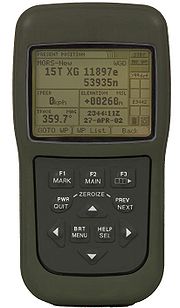
Defense Advanced GPS Receiver
Encyclopedia

United States Department of Defense
The United States Department of Defense is the U.S...
and select foreign military services. It is a military-grade, dual-frequency receiver, and has the security hardware necessary to decode the encrypted P(Y)-code GPS signal
GPS signals
The satellites of the Global Positioning System broadcast radio signals to enable GPS receivers on or near the Earth's surface to determine location and synchronized time. The GPS system itself is operated by the U.S...
.
Manufactured by Rockwell Collins
Rockwell Collins
Rockwell Collins, Inc. is a large United States-based international company headquartered in Cedar Rapids, Iowa, primarily providing aviation and information technology systems and services to governmental agencies and aircraft manufacturers.- History :...
, the DAGR entered production in March 2004, with the 40,000th unit delivered in September 2005. It was estimated by the news source Defense Industry Daily that, by the end of 2006, the USA and various allies around the world had issued almost $300 million worth of DAGR contracts, and ordered almost 125,000 units. The DAGR replaced the Precision Lightweight GPS Receiver
Precision Lightweight GPS Receiver
The Precision Lightweight GPS Receiver is a ruggedized, hand-held, single-frequency GPS receiver fielded by the US military...
(PLGR), which was first fielded in 1994.
Due to the COMSEC electronics inside the DAGR, it is against US federal law for any individual or organization not authorized by the National Security Agency
National Security Agency
The National Security Agency/Central Security Service is a cryptologic intelligence agency of the United States Department of Defense responsible for the collection and analysis of foreign communications and foreign signals intelligence, as well as protecting U.S...
(NSA) to purchase or be in possession of the device. When devices are no longer useful or operational, they are to be returned to an NSA-approved vendor (usually the original supplier), where they are destroyed.
Rockwell Collins also manufactures a GPS receiver known as the "Polaris Guide", that looks like a DAGR, but uses only the civilian C/A code signals. These units are labelled as "SPS", for "Standard Positioning Service", and may be possessed by non-military users.
Features
- Graphical screen, with the ability to overlay map images.
- 12-channel continuous satellite tracking for "all-in-view" operation.
- Simultaneous L1/L2 dual frequency GPS signal reception.
- Capable of Direct-Y code acquisition
- Cold start first fix in less than 100 seconds.
- Extended performance in a diverse jamming environment.
- 41 dB J/S maintaining state 5 tracking.
- 24 dB during initial C/A code acquisition.
- Utilizes Receiver Autonomous Integrity Monitoring (RAIM).
- Selective Availability/Anti-Spoofing ModuleSAASMA Selective Availability Anti-spoofing Module is used by military Global Positioning System receivers to allow decryption of precision GPS coordinates, while the accuracy of civilian GPS receivers may be reduced by the United States military through Selective Availability...
(SAASM) compatible (currently version 3.2). - Wide Area GPS EnhancementWide Area GPS EnhancementWide Area GPS Enhancement is a method to increase the horizontal accuracy of the GPS encrypted P Code by adding additional range correction data to the satellite broadcast navigation message....
(WAGE) compatible. - Resistant to multi-path effects.
- Can be used as survey for weapons systems
- Fielded to the Army, Marine Corps, Navy, Air Force and select foreign military forces
- Designed to fit in a Battle Dress UniformBattle Dress UniformThe Battle Dress Uniform were the fatigues that the armed forces of the United States used as their standard uniform for combat situations from September 1981 to April 2005. Since then, it has been replaced in every branch of the U.S. military. Only the U.S. Navy currently authorizes wear of the...
's 2-magazine ammo pouch - Approximate cost to government per unit to acquire: $1,832
Comparison to PLGR
| Parameter | PLGR | DAGR |
|---|---|---|
| Frequency bands | Single (L1 only) | Dual (L1 & L2) |
| Security | PPS-SM | SAASM SAASM A Selective Availability Anti-spoofing Module is used by military Global Positioning System receivers to allow decryption of precision GPS coordinates, while the accuracy of civilian GPS receivers may be reduced by the United States military through Selective Availability... |
| Display | Text only | GUI Gui Gui or guee is a generic term to refer to grilled dishes in Korean cuisine. These most commonly have meat or fish as their primary ingredient, but may in some cases also comprise grilled vegetables or other vegetarian ingredients. The term derives from the verb, "gupda" in Korean, which literally... with maps |
| Number of channels (satellites) | 5 | 12 (all in view) |
| Anti-Jam resistance | 24 dB Decibel The decibel is a logarithmic unit that indicates the ratio of a physical quantity relative to a specified or implied reference level. A ratio in decibels is ten times the logarithm to base 10 of the ratio of two power quantities... |
41 dB |
| Time to first fix Time to first fix Time To First Fix is a measure of the time required for a GPS receiver to acquire satellite signals and navigation data, and calculate a position solution .-Scenarios:... (TTFF) |
6 minutes | 100 seconds |
| Time to subsequent fix (TTSF) | 60 seconds | < 22 seconds |
| Weight | 2.75 lb Pound (mass) The pound or pound-mass is a unit of mass used in the Imperial, United States customary and other systems of measurement... (1.25 kg) |
0.94 lb (0.43 kg) |
| Dimensions (in inches) | 9.5" tall, 4.1" wide, 2.6" thick | 6.4" tall, 3.5" wide, 1.6" thick (Fits in 2-magazine ammo pouch) |
| Battery life | 13 hours (8 batteries) | 14 hours (4 batteries) |
| Reliability | 2000 hours | 5000 hours |

